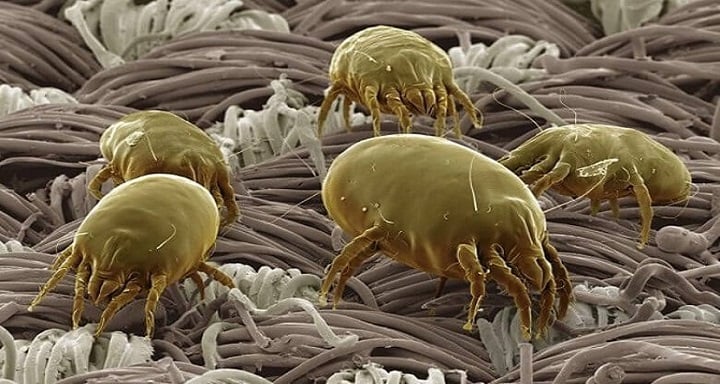How to Get Rid of Dust Mites - A Guide
At the end of a long day, there's really nothing better than climbing into crisp, clean bedsheets and settling down for a good night's sleep.
But, if you're one of the estimated 12 million Brits who suffer from allergies caused by dust mites (NHS), it may not be quite so straightforward.
When you suffer from an allergy or sensitivity to dust mites, even just getting into bed can trigger coughing, sneezing, itching, and skin problems — all of which can make it much more difficult to get the rest we need to stay healthy.
So, what can you do to stop these pesky bugs from ruining your sleep?
While there's no quick fix that will get rid of every single dust mite in your home, there are ways to control the problem and help minimise allergy symptoms.
In this guide, we'll show you how to get rid of bed mites from your sheets, duvets, pillows, and mattress, so you can enjoy a peaceful night's sleep without discomfort. We'll cover:
- What are dust mites?
- What are the symptoms of a dust mite allergy?
- How do I get rid of bed mites?
What are dust mites?
Dust mites (also known as bed mites) live in our homes, particularly in dusty spots. A dust mite's size is extremely small - microscopic, in fact - and typically measures just 0.2–0.3 mm in length, meaning they're invisible to the naked eye.
If you were to look at one under a microscope at x10 magnification, you'd see that it looks like a rounded beetle with a pale-coloured body and eight short legs.
They're a nesting species, and flourish in warm, damp environments. They especially like living in upholstery or carpets, where there are likely to be build-ups of skin cells to feed on.
And, unfortunately, that does mean our mattresses and bedding can be magnets for dust mites.
There are a number of different varieties of dust mites, the most common being Dermatophagoides Pteronyssinus (or the European house mite) and Euroglyphus Maynei (or Mayne's house mite). All kinds of dust mites can trigger allergic reactions.
Bed mites are sometimes confused with bed bugs, which are also commonly found in mattresses and bedding, but they're actually very different.
For one thing, bed bugs are much, much larger — usually around 5mm in length — and are classed as insects, whereas tiny dust mites are part of the mite family. Bed bugs feed by biting our skin and drinking our blood, and affect everybody equally, regardless of allergies. Dust mites, on the other hand, are much too small to bite us, and only feed on dead skin cells.
They generally aren't an issue unless you suffer from an allergy to them.
What are the symptoms of a dust mite allergy?
Dust mites are all around us: even in the cleanest homes, there are likely to be thousands (or even millions) of the bugs in a room at any given time. But, because they're so tiny, most people tend to be blissfully unaware that they're sharing their homes with these microscopic guests. It only becomes a noticeable problem if you’re unfortunate enough to suffer from a dust mite allergy.
The allergen that triggers the reaction is thought to be a protein that is found in dust mite droppings. When these particles are disturbed — like when you get into bed, or walk up a carpeted staircase, for example — they rise up into the air, where we might breathe them in or get them on our skin. Most of the time, this is completely harmless, if a little bit gross to think about. But, for someone with a dust mite allergy, it can trigger a variety of nasty reactions.
The most common symptoms of a dust mite allergy include:
- Sneezing or a runny nose
- Coughing
- Itchy skin
- Skin rashes and dermatitis flare ups
- Postnasal drip
- Asthma flare ups
- Itchy mouth and throat
You'll likely notice these symptoms are triggered by getting into bed, or when you're in a room with lots of carpets, curtains, or upholstery.
It's not known why dust mites cause an allergic reaction in certain individuals, but some people are more at risk than others.
You're more likely to have a dust mite allergy if you already suffer from:
- Other allergies, such as hay fever
- Skin conditions, like eczema or psoriasis
- Asthma or other respiratory problems
Of course, these symptoms might have a number of causes, or you might be allergic to something else in your home. The easiest way to tell if you have a dust mite allergy is to get an allergy test — visit the NHS website to learn more about this.
What are the symptoms of a dust mite allergy?
No one likes the idea of sharing their bed with millions of tiny uninvited guests — especially if you’re unlucky enough to suffer from a mite allergy.
Fortunately, there are a number of things you can do to reduce the number of mites in your bedding, and in your bedroom more generally. This can help to minimise your symptoms and keep your allergies under control.
Here, we’ve shared six methods you can use to get rid of bed mites for good.
Clean your sheets once a week
By far the most effective way to get rid of bed mites is to make sure you’re washing your sheets at least once a week at the highest temperature stated on the care instructions — 60 degrees is ideal.
If you have a tumble dryer, you can also dry the sheets at a high heat, which will help to kill any lingering mites. Washing your sheets, pillowcases, and duvet covers in this way will kill all the dust mites, and will effectively remove the waste matter that causes allergies.
If you have any non-washable blankets, throws, or cushions on your bed, you can still clean them by freezing them for 24 hours, as this will kill the dust mites and remove any eggs. You can also leave them out in the sun for a couple of hours to kill off mites, but be careful, as this may cause discolouration on some delicate items.
Use a mattress protector
As we’ve mentioned, dust mites thrive in warm, damp environments where there are plenty of skin cells for them to feast on, and that means that mattresses can be an absolute paradise for mites, especially as they can be difficult to clean.
Prevention is better than cure, so the best solution is to use a mattress protector to stop mites from getting inside it in the first place. Then, you can simply remove the protector and wash it with the rest of your bedding once a week to get ride of any dust mites that have built up.
We would strongly recommend using a specialist allergy mattress protector, like our Evercomfy Anti-Allergy mattress protector. This is made from a fine material that is designed to catch dust mites and stop them from getting inside your mattress. It also features a layer of soft quilting that adds an extra layer of luxurious cushioning to your mattress.
Clean your mattress
While using a mattress protector is the best way to stop dust mites from getting into your mattress, it’s inevitable that a few bugs will manage to make it around the cover over time.
Of course, you can’t just pop your mattress in the washing machine at the end of every week, like you would with your sheets. But there are some tricks you can use to give it a quick clean.
The simplest way to refresh your mattress is to vacuum the surface every month or so using a handheld Hoover.
You can learn more about taking proper care of your bed in our mattress care and cleaning guide.
Remember, all mattresses will have different care instructions, so be sure to check the label to see if yours has any special requirements.
Dust and hoover floors and surfaces regularly
Cleaning your mattress and bedding regularly can help to remove the number of dust mites in your bed. But it won’t do much to relieve your allergies if dust mites are thriving in other areas of your bedroom.
To effectively control your symptoms, you also need to make sure you’re cleaning the rest of your room at least once a week.
When cleaning, be sure to dust all surfaces thoroughly using a damp cloth or mop head, as dry dusters will just move the dust around, rather than trapping it.
You should also pay special attention to dust magnets like carpets, upholstery, and curtains, taking care to hoover them using a special attachment if necessary.
If your allergies are serious and you’re finding that regular cleaning isn’t enough, you could even consider replacing carpets for hard flooring and installing blinds instead of curtains, as these are easier to clean and don't attract as many mites.
Invest in anti-allergy bedding
To help make your bed dust-mite proof, you could also consider upgrading to allergen-resistant bedding.
Hypoallergenic pillows and duvets are made from synthetic materials that help to repel dust mites and other allergens. They tend to be a better choice than down or feather bedding for allergy sufferers, which can provide a breeding ground for mites.
Many of the duvets and pillows in our Evercomfy bedding collection have anti-microbial and anti-dust mite properties, and they're incredibly soft and comfortable, too. They're also machine-washable, for added convenience and hygiene.
If you're looking to update your mattress in the near future, you should definitely consider investing in one which is designed especially to help repel dust-mites, like our Dormeo Fresh memory foam mattresses. Each one features fine silver threads that offer natural protection against dust mites and is treated using our Sanitized® protection system. So, they're an excellent choice for allergy sufferers.
It's also thought that latex mattresses are naturally hypoallergenic, meaning they're more resistant to dust mites than traditional pocket sprung styles. Not only do latex mattresses help to control allergies, but they're also an incredibly comfortable sleeping option, so it’s well worth considering if your mattress is in need of an update.
Control the humidity
Dust mites love warm, damp environments, and like to feed on certain kinds of mould.
That means, if your bedroom is quite humid and poorly ventilated, the number of mites will increase substantially. You can help to prevent this by controlling the relative humidity level in your bedroom using a dehumidifier — around 50% is thought to be ideal.
It can also help to air out your room by opening the windows at least once or twice a week.
If dust mite allergies are keeping you up at night, try the tips we've shared here, and you should find that your symptoms get much better.
Remember, here at Dormeo, we stock a variety of anti-allergy bedding and mattresses that can help to stop these pesky bugs from disrupting your sleep, so shop with us now to find solutions for your home.
If you’re looking to give your room an anti-allergy makeover, then you may also want to read our mattress buying guide, which will help you pick the right type for your needs. Be sure to take a look at our knowledge hub and sleep FAQs to find more tips and tricks for better sleep, too.






